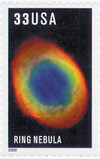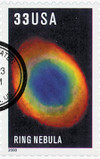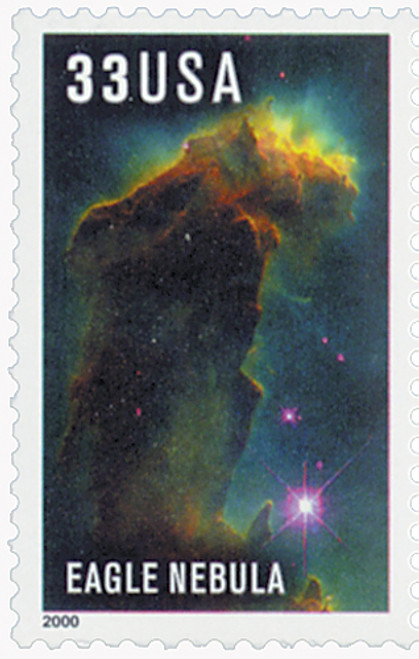
2000 33c Edwin Powell Hubble: Ring Nebula
# 3385 - 2000 33c Edwin Powell Hubble: Ring Nebula
$1.10 - $3.20
U.S. #3385
2000 33¢ Ring Nebula
Edwin Powell Hubble
2000 33¢ Ring Nebula
Edwin Powell Hubble
Issue Date: April 10, 2000
City: Greenbelt, MD
Quantity: 105,350,000
Printed By: American Packaging Corp. for Sennett Security Products
Printing Method: Photogravure
Perforations: 11
Color: Multicolored
City: Greenbelt, MD
Quantity: 105,350,000
Printed By: American Packaging Corp. for Sennett Security Products
Printing Method: Photogravure
Perforations: 11
Color: Multicolored
The space formation called the Ring Nebula has fascinated stargazers for many years. French astronomer Charles Messier first noted the existence of the Ring Nebula, also called M57, over 200 years ago. It lies 2,000 light years from Earth in the constellation Lyra.
The Ring Nebula is one of the best-known examples of a planetary nebula. Images from the Hubble Space Telescope helped scientists determine that M57 has an hourglass, rather than circular, shape. Astronomers had believed it was circular, because in photographs the nebula is seen almost end-on. The faint light at the nebula’s center was once a star of greater mass than our sun. The dying star now appears as a cloud of gas.
Hubble’s image of the Ring Nebula was created by “building up” three black and white photos taken through color filters. Three chemical elements are represented by the colors in the image. Helium appears as the color blue; oxygen is green, and nitrogen gas is red.
The Hubble image on this cover shows the Cartwheel Galaxy, located 500 million light years away. The blue ring around the galaxy is a result of one of the two smaller formations on the right careening through it. The collision sent a ripple of energy into space, and created the gigantic bright-blue ring of new stars.
U.S. #3385
2000 33¢ Ring Nebula
Edwin Powell Hubble
2000 33¢ Ring Nebula
Edwin Powell Hubble
Issue Date: April 10, 2000
City: Greenbelt, MD
Quantity: 105,350,000
Printed By: American Packaging Corp. for Sennett Security Products
Printing Method: Photogravure
Perforations: 11
Color: Multicolored
City: Greenbelt, MD
Quantity: 105,350,000
Printed By: American Packaging Corp. for Sennett Security Products
Printing Method: Photogravure
Perforations: 11
Color: Multicolored
The space formation called the Ring Nebula has fascinated stargazers for many years. French astronomer Charles Messier first noted the existence of the Ring Nebula, also called M57, over 200 years ago. It lies 2,000 light years from Earth in the constellation Lyra.
The Ring Nebula is one of the best-known examples of a planetary nebula. Images from the Hubble Space Telescope helped scientists determine that M57 has an hourglass, rather than circular, shape. Astronomers had believed it was circular, because in photographs the nebula is seen almost end-on. The faint light at the nebula’s center was once a star of greater mass than our sun. The dying star now appears as a cloud of gas.
Hubble’s image of the Ring Nebula was created by “building up” three black and white photos taken through color filters. Three chemical elements are represented by the colors in the image. Helium appears as the color blue; oxygen is green, and nitrogen gas is red.
The Hubble image on this cover shows the Cartwheel Galaxy, located 500 million light years away. The blue ring around the galaxy is a result of one of the two smaller formations on the right careening through it. The collision sent a ripple of energy into space, and created the gigantic bright-blue ring of new stars.













